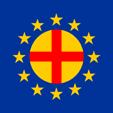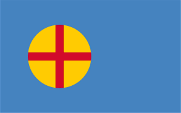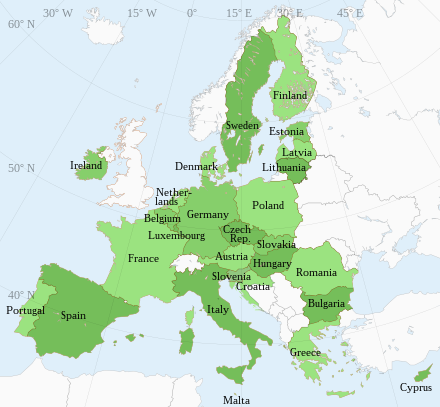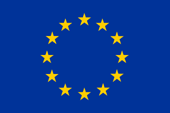
In 1986 the European Council get agreed about the European flag, which became to the emblem of the European Union. It shows twelve golden five-pointed stars in form of a circle on cobalt blue ground as symbol of the union of the peoples of Europe. The number of stars is unchangeable. Twelve is the symbol of perfection and unity. That means that this cipher stands not for the number of members in the union.The colours are regulated accordingly in the European Commission's Guide of 1996 and the Council of Europe's Guide of 2004, as Blue = CMYK 100|80|0|0, which would correspond to Pantone Reflex Blue, and as Yellow = CMYK 0|21|100|0, which would correspond to Pantone 123.
Source: Wikipedia (EN)


Flag of the Pan-European Movement,
Thanks to Peter Diem, Media Research, peter-diem.at

by Count Richard of Coudenhove-Kalergi in 1952 proposed flag for Europe,
Source, by: kohoutikriz.org

Richard Count of Coudenhove-Kalergi, a political author, * 16th of November 1894 in Tokio, † 27th of July 1972 in Schruns (Vorarlberg), was the founder and Secretary General of the Pan Europe Movement. In addition to many works about the European unification he created in the twenties of the 19th century the Pan Europe Flag. It was quadratic and carryed a red cross amid a golden disk, surrounded by a wreath of twelve golden vive-pointed stars on a dark blue bunting. After the establishment of the European Council in the year 1949 were made various proposals for a flag for this organization. Coudenhove-Kalergi proposed in the year 1952 a flag, which was similar to those of the Pan Europe Movement, but it did not carry the twelve stars. Because of its Christian appearance it was rejected by Turkey. (look this link at the European Council itself: https://www.coe.int/en/web/documents-records-archives-information/european-flag)
Source: Volker Preuß
Paul M. G. Lévi, the chief of the department of culture of the European Council created in the beginning of the fifties a flag for the European Council. He proposed initially a flag which was similar to those of the Pan Europe Movement. But it contained anymore the golden disk and the cross and the number of the stars was heightened to fifteen. Those should represent the states which are members in the European Council. Because that concept should have included the Saarland as an independent member of the European Council Germany rejected this draft. Since its establishment in the year 1949, the European Council saw the need to give Europe a symbol wherewith Europes inhabitants could identify. On 25th of October in 1955 the parliamentary congregation passed the unanimous decision to adope as emblem a circle of golden stars on blue ground. On 8th of December in 1955 the minister's committee adoped the following as the European flag: On the blue sky of the western hemisphere the stars represent the nations of Europe in a circle, the symbol of unity. Their number has to be always twelve, the symbol of perfection and finishing. In the same way like the twelve signs of the Zodiac represent the whole universe stand the twelve golden stars for all nations of Europe – including those which still can not participate in the construction of Europe in unity and peace. On 11th of April in 1983 the European parliament adoped that flag as the official symbol for the European Union.
Source: Peter Diem, Media Research, Wien, peter-diem.at/, gestützt auf offizielle Texte des Europarates und zeitgenössische Medienberichte
About the motivation and the stimulus of the in the European flag history engaged persons there are quite different descriptions. Three of them should be briefly exhibited here:
• The twelve stars – especially those in the by Richard Count of Coudenhove-Kalergi created flag of the Pan Europe Movement – should descent out of the biblical "Apocalypse of the Johannes" (Revelation 12,1): "And there arised a large sign on the heaven: a woman clothed by the sun, and the moon underneath her feet and upon her head a crown of twelve stars." That concept should then be transfered from the twelve-star flag of the Pan Europe Movement to the twelve-star flag of the EU.
• The flag of Europe should have its origin in the times of the Second World War. Paul M. G. Lévi – a Belgian of jewish descent – made the vow that he if he should survive the war, would change to the catholic religion. He survived and became catholic. On 5th of May in 1949 was established in London the European Council and Paul Lévi became Chief of the Department of Culture of the European Council. In the in 1952 emerging flag discussion all designs in which – perhaps by the example of the scandinavian flags – was contained a cross should have been rejected by the socialists as ideological bonded and as much to christian. Once day Lévi passed a Maria statue with a wreath of stars. Shining reflected by the sun the golden stars glowed in front of the blue heaven. Lévi should have visited after that Count Benvenuti – a Venetian christian democrat and then Secretary General of the European Council – and suggested him to propose twelve golden stars on blue ground as motive for the flag of Europe what became accepted generally.
• Paul M. G. Lévi – Chief of the Department of Culture of the European Council – should as jew have been guided by anti-christian ideas as he created that flag. The basic thought was the rejection of the hitherto Pan Europe Flag because it contained a cross and should in this way enabled associations to the Christianity. The story about the wreath of stars of Maria should have been invented by him only to compensate the delete of the cross anyhow, to make the Flagge popular nevertheless and especially at Catholics.
Source: Jörg Roggenbuck
When Richard Count of Coudenhove-Kalergi (1894–1972) confirmed in a personal statement that three high-ranking Catholics in the European Council elected "subconsciously" the twelve stars by the model of the biblical "Apocalypse of Johannes" (Revelation 12,1), announced Paul M. G. Lévi – press functionary of the European Council between 1949 and 1966 – in the year 1989 that there were none religious intentions – or whatever will be linked with it – at the choose of the circle with the twelve stars. The number twelve was picked as the symbol for perfection and stability.
Source: Peter Diem, Media Research, Wien, peter-diem.at/

Map of the member states:

Source: wikimedia.org

Area: 1.634.967 square miles
Inhabitants: 446.800.000 (2022), thereof 18% Germans, 15% French, 13% Italians, 10% Spanish
Density of Population: 273 inh./sq.mi.
Capitals:
– Seat Council/Commission: Brussels
– Seat of the Parliament: Strassburg
– Seat of the Court: Luxemburg
Currency: 1 Euro (EUR, €) = 100 Cent
Time Zone: GMT to + 3 h
Source:
Wikipedia (DE)

Belgium
Bulgaria
Denmark
Germany
Estonia
Finland
France
Greece
Ireland
Italy
Croatia
Latvia
Lithuania
Luxembourg
Malta
Netherlands
Austria
Poland
Portugal
Romania
Sweden
Slovakia
Slovenia
Spain
South Cyprus
Czechia
Hungary

1951 · The way to the European Union startet in 1951. At that time established six western European states in Paris the European Community for Coal and Steel (ECCS). It were: Belgium, the Federal Republic of Germany, France, Italy, Luxembourg and the Netherlands. They planed right from the beginning more than only a common market for Coal and Steel. In the founding treaty is signifyed that the six states are resolved "to place the first foundation stone for a further and heighten community under the nations which were divided for long times by bloody quarrels by the establishment of an economic community".
1957 · That six ECCS states established in Rome the European Economy Community (ECC) and the European Nuclear Community (EURATOM). They had "the steady will to create the foundations for a more closed combination of European nations", how formulated in the founding treaty of the ECC. In the ECC the common politics were expanded from the field of coal and steel for further fields of the economy, e.g. for agriculture, fishery, traffic system, law of competition and export trade. The membering states decided to establish within twelve years a common market, so an internal market. That took more time, but with the start of the year 1993 that moment was come: The internal market was "opened".
1968 · The ECC completed the customs union: thereafter importations and exports between ECC states are duty free.
1972 · The ECC states decided that they would cooperate in further fields of politics: energy policy, regional policy, environment policy.
1973 · Out of six become nine: Denmark, Ireland and the United Kingdom of Great Britain and Northern Irelan join the ECC, ECCS and EURATOM.
1979 · the delegates of the European Parliament were elecetd for the first time directly by the eligibles to vote in the nine states of the community.
1981 · From now on there are ten: Greece joined.
1986 · The number of the membering states increased to twelve: Portugal and Spain joined. In the same year decided the membering states a first and comprehensive change of the founding treaties – the Consistent European File – and set a datum for the completion of the internal market in 1992.
1992 · The twelve states signed in the Dutch town Maastricht the "Treaty about the European Union". It came into force on the 1st of November in 1993. It expanded the fields of politics in which they cooperate. Now were added: education, culture, health service, consumer protection, industry, foreign aid, foreign affairs and safety policy, justice, interior.
1993 · The internal market is realised since the 1st of January in 1993.
1995 · Three further states joined: Finland, Austria and Sweden.
1997 · On the summit meeting in June in Amsterdam were passed the stability and increase pact as well as comprehensive changes of the existing treaties.
1999 · Am 1st of January: onset of the European Currency Union in eleven states of the EU. In the 1st half-year Germany acts the presidency in the EU. On the summit meeting of the European Council in Berlin was passed the "Agenda 2000", on the summit in Cologne the European Employ Pact.
2002 · The Euro comes as cash: On 1st of January become emited the Euro notes and Euro coins.
2004 · The number of the membering states increased up to twentyfive: Lithuania, Latvia, Estonia, Malta, Slovenia, Hungary, Slovakia, Czechia, Poland and South Cyprus joind.
2005 · The attempt to introduce an "European Constitution" failed because of the "no" of the in a plebiscite consulted French and Dutch population. Because of that Great Britain moved the referendum into undecided times. In many other European states voted exclusively politicians about the acceptance of the "European Constitution" and those agreed most in opposite to the population.
2007 · Rumänia and Bulgaria become members of the European Union.
2008 · The attempt to introduce an "Europäischen Treaty" instead of an "European Constitution" failed because of the "no" of the in a plebiscite consulted Irish population. The President of Poland pronounced that he don't subscribe the treaty.
2013 · Croatia becomes a member of the European Union.
2016 · A referendum in United Kingdom decides with a majority to leave the European Union.
31st of Janauary in 2020 · United Kingdom leaves the European Union
Source: Volker Preuß

The word "Europe" has its roots in the semitic word "Ereb", what means "evening". Europe is the "Land of Eve".
Source: Handbuch der geographischen Namen


![]()







![]()
